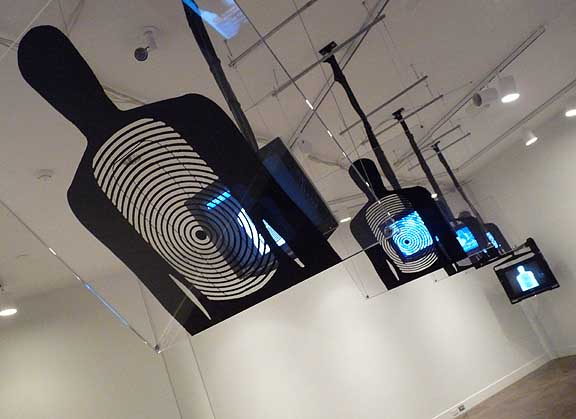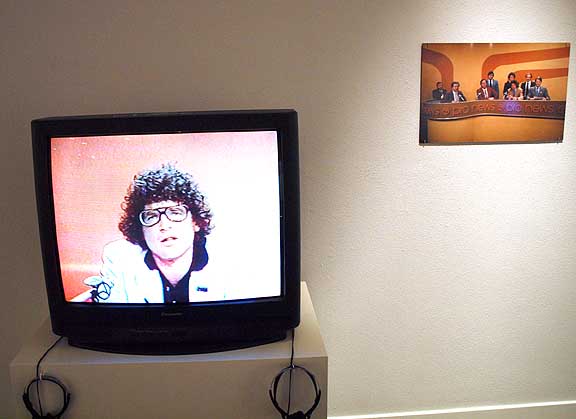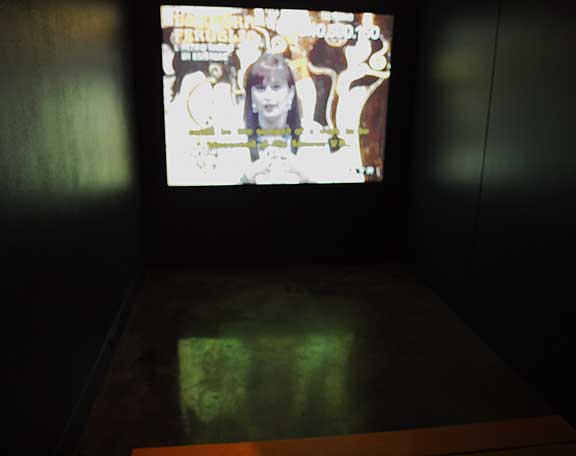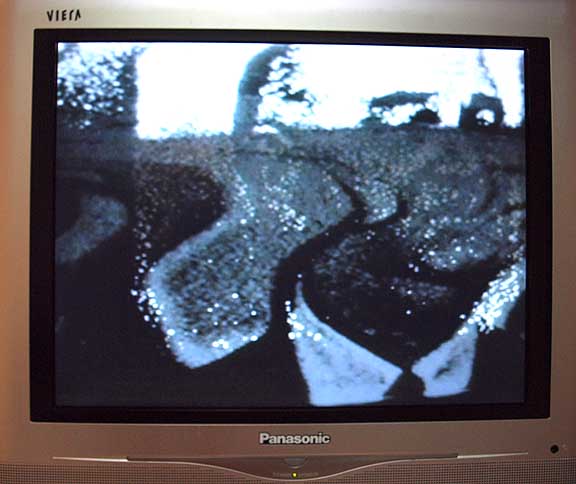
Hostage, Dara Birnbaum, 1994
Lewis and Clark's Hoffman Gallery showcases a didactic display of the questioning of media this month in its exhibition Broadcast. The pieces in Broadcast span a timeline originating in the 1960's and includes a lineup of artists whose commentary ranges in tone from absurdist to anarchist, mystic to murderer. Broadcast applauds a criticality that is at once satirical and provoking, the absence of which, it warns, engenders an inertia of thoughtlessness that is as sneaky as a flu and as dangerous as anthrax.
Upon entering the gallery, Sieben Versteeg's "CC 2003" consists of a simple monitor situated unassumingly next to the show's title. The talking heads of reputable anchors report a silent copy, and the mind, as the mind tends to do, starts to insert the conditioned, lilting syncopation of television news copy. The closed captioning runs a diligent, hypnotic ticker beneath the moving mouths, and if one overlooked the content of this text, this could be any other close captioned monitor in any airport, sports bar, waiting room, or fitness center. Yet when read, the moving lips of these talking heads begin to bleat confessions of the candid teenage sort. All of a sudden, the content of our televised vocal conduits is cheap and emotional. Ironically, consciousness is somewhat reawakened while coincidentally turning the evening news into a bit of a laughing stock. CC 2003 and The Amarillo News Tapes, situated farther back in the gallery, become the Rosencrantz and Guildenstern of this exhibition, a pair of absurdist blasphemers, desecrating the haloed sanctity of the trust we place in an evening news delivery.

The Amarillo News Tapes, 1980, Doug Hall, Chip Lord, and Jody Procter
As the viewer pulls him or herself away from the lull of Anderson Cooper's sudden barrage of feelings, the tarp of Gregory Green's piece, "WCBS Radio Caroline, The Voice of the New Free State of Caroline (Detroit)" (2007) sits set up and waiting, as if its lax, renegade D.J. has just stepped out for a cigarette and left the tape rolling. Green's piece is reminiscent of a time before Clear Channel overwrought the airwaves and broke them with its ownership, a time when disc jockeys' personas and subsequent musical inclinations were as particular to themselves and their locales as the taste of its water. The overarching feel of human-ness is pervasive as WCBS' conjures an essence of a presence, of a body having just been there, with the doodles and brainstorming of upcoming playlists on lined yellow notepads, with its scattering of empty beer bottles and DIY music demos. The fact that the mock radio station actually transmits a signal morphs the gallery into an alternate, renegade dimension. The role of gallery goers shifts from spectating audience into fist-pumping anarchist and general dissident. It is a nostalgic, interactive piece , apropos for the front of the space.
Adjacent to Green's piece sits the transmitting boob tube of TVTV: Top Value Television's "Four More Years" (1972). This video collective's work was politically radical for its time, yet their savvy feels relevant today. "Four More Years" is fraught with satire and humor that is not only ideological but visual. Cameraman acts as political cartoonist, drawing revealing caricatures of those put in the spotlight during a political campaign. TVTV's questioning of and resultant comic commentary on the validity of the election process, while very common now, knocked a kink into the political chain and national ideology of 'America for its own sake'. Interspersed with the footage of inane political events, there are the stoic painted faces and musical marches of protesters. Their apparent youth is startling, their images as foil to the political coverage a pungent tactic in portraying the sullied promises of a faulted political party.
Chris Burden's "TV Hijack, February 9, 1972" is a violent but effective reaction to what must have been an incredibly oppressive media. His work is a poetic and simple slashing (no reference to Phylis Lutjean's vulnerable throat here) of what Burden considered to be a heinous lack of critical thought by the general public. Not only was he creating a new venue in which to express his ideas, these ideas most likely reached a far greater number of people than if he had exhibited in a gallery, and is perhaps impossible now in the digital age of broadcasting. Burden's method emanates both a courageous integrity and somewhat of a desperation in its delivery; Burden either believed the television broadcast to be the only way to reach the American public, or was so enraged by its vapidity, he decided to take it over and fill it with content.
Christian Jankowski's piece, "Telemistica" (1999) conducts his query of media in Venice, using himself as guinea pig as he phones various television psychics to inquire about how his work will be received. In this inquiry, he questions what we place our faith in: God?, Art?, Love? Televised Psychics? Broadcasted Material as Truth? "Telemistica" infers an oxymoron, or perhaps an occurrence novel of the times, resulting in the new phenomena of the televised mystic. "Telemistica" creates somewhat of an eerie visual harmonic to the chorus of the rest of the voices in this first room.

Telemistica, 1999, Christian Jankowski
This is the meaty melange that comprises Broadcast's foyer. These pieces together provide a healthy foreshadowing as to the enormous conceptual range of this exhibit. Continuing into the heart of the gallery, Nam June Paik's painterly piece acts as a bridge, a minimalist visual poem a la Bruce Nauman and Jonathan Lasker, a quiet segue into the rest of the exhibit that simply and eloquently draws attention to the aspect of materiality. Paik advises a retention of perspective when viewing the sneaky film medium; it can draw you in so quickly and unknowingly. Paik's simple piece is the summary of the exhibit itself, and as viewers continue on to the rest of the show, the image of Paik's finger bending
and warping the film plane lingers.

Video Tape Study No. 3, 1967-69, Nam June Paik
One of Broadcast's most startling effects as an exhibition is its granting of historical perspective. Very few galleries here in Portland have access to much older work, and the added element in conciousness this provides is quite powerful. Actively snarky and satirical artists grant the past more of a three dimensional, living quality than the two dimensionality history seems to carry merely as an idea. While the questioning of media bias in this day and age is not a new topic, this exhibition sheds light on its vital importance to the survival of our freedom of thought and expression. As this past month marks the twentieth anniversary of the fall of the Berlin Wall, the memory of a time when media was more than questionable resurfaces. WIth this memory, Broadcast's relevance becomes even more apparent. The subtle mix of renegade humor and urgent warning is a rich reminder of the danger of blind acceptance. Broadcast is not to be missed!























